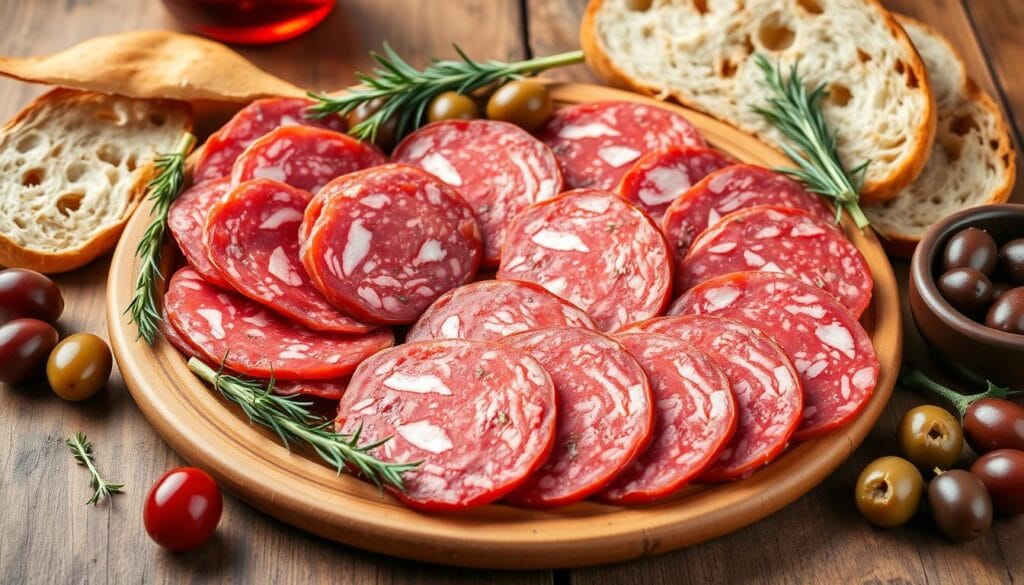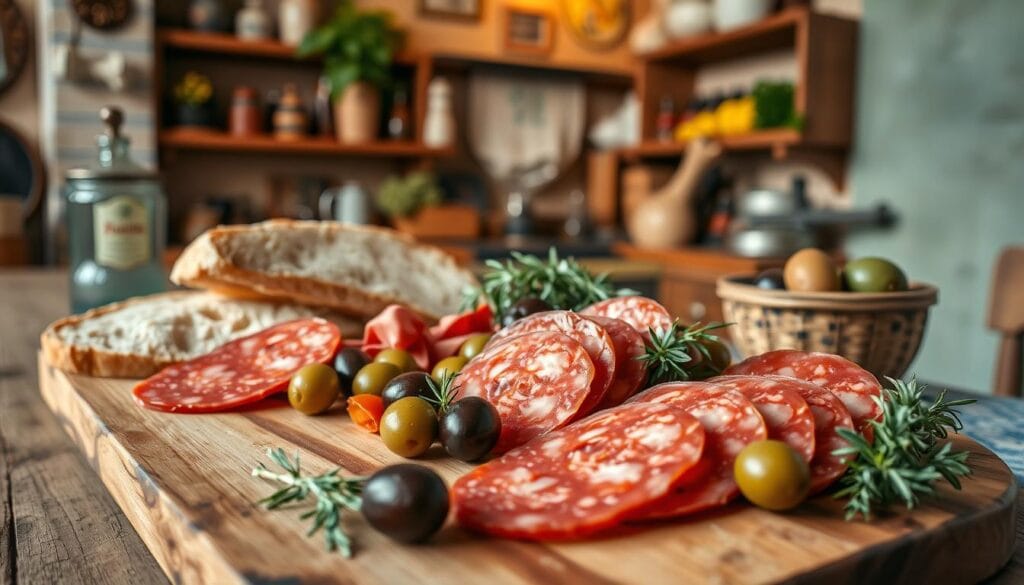
Ever felt a room fill with the scent of savory meats? That’s the magic of good food. Soppressata, Italy’s favorite cured sausage, brings back memories with its rich taste and history. It’s more than food; it’s a link to family traditions and cultural experiences.
Imagine sharing a charcuterie board with loved ones. Soppressata is the star, sparking stories and laughter. This treat has won hearts worldwide, becoming a staple in Italian cuisine and beyond.
We’ll explore Soppressata’s origins, how it’s made, and its unique flavors. From sweet to spicy, there’s a taste for everyone. Let’s journey through the traditions that make Soppressata a beloved dinner favorite.
Table of contents
Introduction to Soppressata
Soppressata is a mix of tradition and Italian food culture. It’s more than just a cured meat. It shows the diversity and history of different regions. Made from pork, it can also include beef or other meats, creating a variety of tastes and textures.
Soppressata di Calabria is famous for its spicy taste, thanks to chili peppers. It has a PDO (Protected Designation of Origin) status. On the other hand, Soppressata di Basilicata has milder flavors, passed down through generations. The Soppressata from Puglia adds fennel seeds, making it unique.
The curing process can take weeks to months, showing the skill in making Soppressata. It’s not just tasty; it’s also a good source of protein and nutrients. But, it’s important to eat it in moderation because of its fat and sodium. Now, you can find lower-fat or low-sodium versions in stores.

What is Soppressata?
Soppressata is a tasty Italian salami with deep roots in Italy’s food culture. It’s mainly made from pork and tastes different in each region. Over time, it has become a favorite, thanks to generations of skilled makers.
The Origin of Soppressata
Soppressata comes from many parts of Italy, each adding its own special touch. Soppressata di Calabria is spicier, thanks to chili peppers and a PDO status. On the other hand, Soppressata di Basilicata is milder, sticking to old ways of making it. In Puglia, fennel seeds give it a unique flavor, showing the area’s farming influence. Everywhere, soppressata is a sign of local pride and skill.
Types of Soppressata: Sweet vs. Spicy
Soppressata comes in two main types: sweet and spicy. Sweet soppressata is milder, perfect for those who like a softer taste. It lets the pork flavor stand out. Spicy soppressata, on the other hand, has hot pepper flakes or spices for a bolder taste. People can pick what they like best.

The Traditional Crafting Process of Soppressata
Making Soppressata is a cherished tradition in Italy. It shows great care at every step. The process uses special curing methods to bring out the best in the ingredients. Artisans turn simple pork into a delicious treat, making sure each bite is true to its roots.
Curing Techniques and Methods
The process starts with choosing the right meat, mainly pork. This is because pork has the right amount of fat. The meat is first dry-salted, with salt making up 2.5-3% of the meat’s weight.
Then, natural spices are added, followed by starter cultures like Lactobacillus and Pediococcus. These cultures ferment the meat at temperatures between 20-30°C (68-86°F) for one to three days. This step is key for developing the meat’s rich flavors.
After that, drying is done. This can take weeks to months. The conditions are carefully controlled to keep the right humidity and temperature. These steps not only improve the taste but also help preserve the meat, showing the true art of curing.
Importance of Quality Ingredients
Choosing the right ingredients is critical for it. Pork from trusted farms gives the meat its unique taste. The use of fresh spices and herbs adds to the flavor, making each bite a true taste of Italy.
This focus on authenticity makes every slice special. It invites fans to enjoy the deep flavors that come from such hard work and dedication.

Flavor Profile of Soppressata
The flavor profile is a mix of savory, sweet, and spicy. Each bite is a complex blend of rich flavors. This makes it a favorite in Italian cuisine.
Texture and Aroma
The texture and aroma are key to its charm. It can be coarse or smooth, depending on the fat and curing process. The aroma, filled with herbs and spices, is captivating.
Balancing Sweetness and Spiciness
This salami balances sweetness and spiciness perfectly. Its Southern Italian roots, like Calabria, add to its flavor. Recipes use special spices to deepen its taste.
It is great on charcuterie boards or in gourmet meals. Its balanced flavors make it a joy to eat.
How to Use Soppressata in Your Cooking
It adds a unique touch to any dish, perfect for charcuterie boards. It pairs well with cheeses, fruits, and spreads. This makes cooking with it both fun and rewarding, whether you’re hosting a party or just want to enjoy a meal at home.
Incorporating Soppressata in Charcuterie Boards
Using it in charcuterie boards is an art. To make a great board, include:
- A variety of cheeses, such as aged provolone and creamy mascarpone
- Fresh fruits like figs and grapes for a touch of sweetness
- Crunchy breadsticks or artisan crackers for texture
- Garnishes like olives and nuts to provide contrasting flavors
- A drizzle of honey or balsamic glaze to enhance the savory notes
With Soppressata on the board, guests can try different combinations. This makes the board a hit, sparking conversations and fun.
Recipe Ideas Featuring Soppressata
Want to take your cooking to the next level? Try recipes with it. A great choice is Sweet Potato & Caramelized Onion Pizza with it and Balsamic Glaze. Here’s how to make it:
- Prep sweet potatoes and onions, caramelizing them to perfection.
- Make the pizza using DeLallo Pizza Dough Kit. Layer sweet potatoes, caramelized onions, and Soppressata.
- Use provolone and mascarpone cheeses for a rich taste.
- Bake at a high temperature for a golden crust and melted cheese.
This recipe takes about 3 hours and 10 minutes to make. It’s a flavorful dish that’s sure to impress.
Soppressata Pairings: What Goes Well with It?
Pairing Soppressata with the right wine and cheese makes for a special meal. The rich and spicy flavors of this Italian treat can be matched by many foods. The right mix brings out the best in every bite.
Best Wines to Complement Soppressata
Choosing the right wine for Soppressata can turn a meal into a memorable event. Here are some top picks:
- Chianti: This Italian red wine, known for its acidic profile, balances the savory qualities of Soppressata perfectly.
- Prosecco: A sparkling wine that adds a refreshing touch with its fruity notes, pairing well with the spices in the meat.
- Behler Merlot: Works harmoniously with rich, savory flavors.
- Wild Oak Chardonnay: Complements creamy cheeses on the charcuterie board.
- Moon Mountain Cabernet Sauvignon: Its boldness pairs excellently with sharper, nutty flavors.
Cheeses that Make a Perfect Match
The right cheese can make Soppressata pairings even better. Try these:
- Aged Gouda: Its nutty flavors complement the spiciness of Soppressata.
- Brie: The creaminess of this cheese contrasts beautifully with the texture of the cured meat.
- Sharp Cheddar: Offers a robust flavor that stands up to the intensity of Soppressata.
- Goat Cheese: Provides a tangy taste that pairs well with slightly sweet cured meats.
- Blue Cheese: Adds a punch of flavor that enhances the rich savory notes.
Health Benefits of Soppressata
Looking into the health benefits of Soppressata shows it can be good for you when eaten in small amounts. This tasty cured meat, known for its deep flavor and old-fashioned making, can fit into a healthy diet. It’s best when paired with other nutritious foods.
Nutrition Facts
Boar’s Head Uncured Soppressata has 2.5 grams of saturated fat and 430 milligrams of sodium per ounce. It’s a big part of a charcuterie board or meal. Enjoying Soppressata’s taste and making it yourself is key. But, watching how much you eat is also important for its health benefits.
Eating it with foods high in fiber can help balance out the fat and sodium. This way, you can enjoy cured meats more fully.
Why Choose Cured Meats?
Soppressata and other cured meats are great sources of protein. Protein is important for keeping muscles strong and healthy. Yet, it’s true that processed meats can be bad for you, mainly because of their sodium and fat.
Choosing high-quality, responsibly made cured meats can help. These meats usually have fewer additives and are more nutritious. Adding cured meats to your meals can make them more exciting while keeping health in mind.
Making Homemade Soppressata
Making homemade it is a fun way to dive into an old tradition. It brings Italy’s rich flavors into your kitchen. It also lets you create your own special dish. Here’s a quick guide to help you make it with ease.
Essential Tools and Ingredients
To make homemade it, you need some special tools and fresh ingredients. Here’s what you’ll need:
- Meat grinder
- Mixing bowls
- Hog casings
- Kitchen scale for precise measurements
- Knives and cutting board
For the ingredients, you’ll need:
- 6-8 pounds pork shoulder
- Pork back fat, around 20-30% of the meat mixture
- Salt (2.5-3% of total meat weight)
- Black peppercorns and red chili peppers for seasoning
- Starter cultures designed for salami production
Step-by-Step Process of Homemade Soppressata
Starting to make homemade it is a series of steps. Follow this guide:
- Prepare Meat: Cut the pork shoulder and back fat into small cubes for easier grinding.
- Combine Ingredients: Mix the pork with salt, spices, and starter cultures in a large bowl.
- Grind the Mixture: Use a meat grinder to grind the mixture evenly.
- Stuff into Casings: Fill the hog casings with the mixture, being careful not to overstuff.
- Fermentation: Let the stuffed sausages ferment at room temperature (around 70°F) for 24 hours.
- Curing: Move the soppressata to a controlled environment with temperatures of 55-60°F and 65-75% humidity, curing for 3-6 weeks.
- Drying: Check if the soppressata has lost 30-35% of its weight, which means it’s ready to enjoy.
Trying to make homemade soppressata improves your cooking skills. It also helps you appreciate the flavors and history of this Italian dish. Enjoy the process and the delicious results.
Soppressata Around the World
It shows its rich heritage in many cultures. It has become a favorite in different parts of the world. This Italian delicacy has changed, blending with local tastes.
Exploring these global styles is fascinating. It shows how this food has grown, becoming a staple in American cuisine too.
Regional Variations and Distinctive Styles
In different places, it has its own special taste. For instance:
- Italian areas have their own flavors, with some adding spicy ‘Nduja.
- In Germany, it’s called Presssack, and in Korea, it’s known as 헤드.
- Every version keeps the traditional making methods but adds local spices and ingredients.
Popularity in American Cuisine
In the U.S., Soppressata is a big hit on menus everywhere. Chefs like Tony Gemignani, a 13-time World Pizza Champion, use it in gourmet pizzas. It adds a bold flavor to dishes:
- Upscale sandwiches feature Soppressata, giving a rich taste.
- Pizzas with Soppressata, figs, and even purple potatoes show a trend of creativity.
- Classic pairings in dishes highlight Soppressata’s versatility.
Soppressata: A History of Tradition
The story of it is deeply rooted in Italian food traditions. This favorite cured meat has a long history, showing how communities used to preserve food. These methods were key for keeping food fresh in rural areas, where family recipes and local specialties thrived.
In Italy, every region has its own style. This is because of the local climate, ingredients, and history. For example, Southern Italy’s version is sweet and spicy, thanks to Mediterranean herbs. In contrast, the north’s version is milder, with a focus on meat and fat.
For centuries, it has been more than just food; it’s a symbol of family and community. The love for quality ingredients is a tradition that continues. When you enjoy it, you’re experiencing Italy’s rich farming history and the hard work of many artisans.
Finding Authentic Soppressata
For those who love Soppressata, finding the right place to buy it is key. It’s important to get the real deal, whether you’re shopping in local markets or online.
Where to Purchase Quality Soppressata
There are many trusted places to find authentic Soppressata. Here are some options to consider:
- Specialty Food Stores: These shops in cities often have gourmet items, including local and imported Soppressata.
- Italian Delis: Italian delis are great for finding cured meats. The staff there can help you pick the best Soppressata.
- Online Retailers: Look for online stores that focus on Italian foods. They offer a wide range of Soppressata that can be shipped to you.
Labeling and What to Look For
When picking Soppressata, knowing what to look for on labels is important. Here are some tips:
- Protected Designation of Origin (PDO): Check for DOP labels, like Soppressata di Calabria. This means it’s made the traditional way.
- Ingredient Transparency: Good Soppressata lists its ingredients clearly. It should have pork and natural seasonings.
- Fat Content: Choose Soppressata with the right amount of fat. It should be tasty but not too greasy.
By following these tips, you can find the best Soppressata. It will make your meals even more delicious.
Conclusion
It is more than just a tasty cured sausage. It’s a symbol of rich flavors and cultural traditions. The skill in making it shows a deep love for keeping culinary heritage alive. It invites us to enjoy history with every bite.
Its ability to add flavor to many dishes makes it a favorite in kitchens everywhere. From charcuterie boards to fancy meals, it is a staple. It’s loved by many for its versatility and taste.
When you try it, remember the hard work and quality ingredients that go into it. Learning about its history helps us connect with the culinary world. It’s a way to enjoy great taste while honoring traditions.
Exploring it teaches us to value food beyond its taste. It shows how food can celebrate cultural legacies. So, as you enjoy it, remember it’s a tribute to its heritage.
FAQs:
- What is the difference between Soppressata and salami? Soppressata is a coarser, Italian cured sausage, while salami is a broader category of cured sausages that can have a finer texture. Soppressata often has a spicier or sweeter taste compared to salami.
- What does Soppressata taste like? Soppressata has a rich and savory flavor, with a blend of spicy, sweet, and savory notes from pork, herbs, and spices.
- How do you pronounce Soppressata? Soppressata is pronounced as “soh-preh-SAH-tah.”
- Is Soppressata like capicola? While both are Italian cured meats, Soppressata is typically coarser and spicier, whereas capicola is a more delicate, dry-cured pork shoulder or neck, often milder in flavor.
